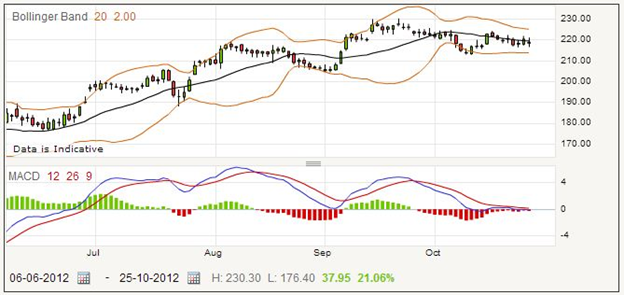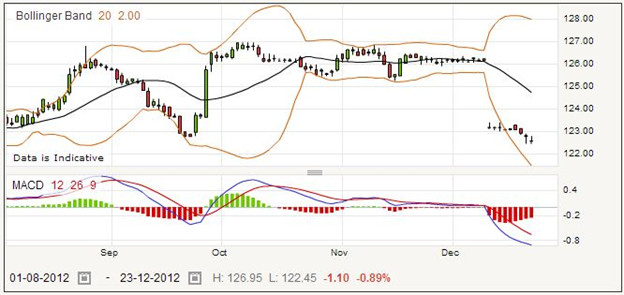Is Private Equity Group 3i Flying too High?
The 3i Group is the latest version of a venture capital company which started in 1945 and has grown into a £2.9 billion cap as at 31 December 2012. The spread betting price chart below shows that it is growing incrementally, but still a long way from its peak value of nearly 800 which it achieved just before the economic meltdown.

3i Infrastructure is an infrastructure investment company strongly related to the 3i Group, which holds 46% of the stock. Its daily price performance, shown in the chart below, could make you think twice before spread betting on it.
The company started as the Industrial and Commercial Finance Corporation (ICFC), and was inspired by the government trying to assist small businesses post-war. It was initially formed by the major banks. It expanded considerably after 1959, when it was allowed to raise outside funds. In fact it became the largest provider of growth capital for small unquoted companies in the UK.
Finance Corporation for Industry was a company also formed in 1945 with the intent of financing large companies, and ICFC combined with it in 1973 to form a company called Finance for Industry. In the 80s it specialized in management buyouts and expanded to the international markets. In 1983 its name changed to Investors in Industry, which is where the shorthand name of 3i originated.
3i now has three divisions, including private equity, infrastructure, and debt management. It operates in 13 countries and has more than £10 billion assets under management. The move to becoming an investable company happened in 1987 when the banks sold off their stakes, and the company was floated on the stock exchange in 1994.
This company is headquartered in Jersey, and was first listed on the London Stock Exchange with an Initial Public Offering (IPO) in 2007. Its investing focus is Europe and Asia, with an emphasis on utilities, transportation, and social infrastructure.
The 3i Group now concentrates on midmarket buyouts, capital for growth, and infrastructure financing, and its current market sectors include healthcare, consumer, industrial, energy, and financial services. Its profits depend on the skill of its management in selecting and running the financing projects in which it specializes. As you can see from the chart, its share price is volatile, corresponding to the risks and rewards of company financing.
3i Group
3i Group, which is also listed on the FTSE 250 index, is the main company and operates as a private equity and venture capital company. This was formed in 1945 by major banks to provide long-term investment funding for businesses after the Second World War. It became 3i Group in 1987 when the banks sold off their stakes to form a PLC, and was floated on the London Stock Exchange as a public company in 1994.
The reason for concern as a spread better is that the general volatility appears fairly low, encouraging you to place large bets, but there are one or two major price jumps which could catch you out if you were the wrong side of the move. Look for instance at the end of September, where the three-point loss suffered during the whole of September was suddenly regained, mainly in one candlestick, which is one day’s trading.

More alarming still is the large gap in December 2012, with a drop of nearly 3 points and no intervening prices. This means that no matter how carefully you were watching the markets, you had no way in which to close out your position at any intermediate level and you would have to take the whole loss, should your bet be the wrong way. You can get around this by placing a guaranteed stop loss with your spread betting provider, but as you always have to pay for this with a larger spread, to do this routinely would eat into your profits.
3i Group Rolling Daily: How to Spread Bet on 3i Group shares?
Going Long
Should you wish to spread bet on the 3i Group, you may choose to take out a rolling daily bet for which the current quotation is 217.55 – 218.65. With a long (buy) rolling daily bet you are wagering that the price will increase, and you might choose to stake £5.50 per point on the buying price of 218.65.
Assuming that your bet works out, you might find that you are able to close your bet and collect your winnings when the spread bet quote is 269.60 – 270.70. To work out how much you have won, you have to figure how many points you gained. Your bet was opened at the buying price of 218.65, and it closed at the selling price of 269.60. That means you have made a total of 50.95 points with your bet. Multiplying by your stake, your winnings amount to £280.22.
When you are trading in the markets, you must always consider that each individual bet might fail. Your goal is to increase your wealth by winning more than you lose. Consider that the price might have gone down, and you would have to close your bet to avoid further loss. Perhaps you closed your bet when the price went down to 177.20 – 178.30. Your starting price was 218.65, as before, and this time your bet closed at 177.20. 218.65 minus 177.2 is 41.45 points. That means this bet would have cost you £227.98.
If you do not have time to watch the markets, you may choose to use a stop loss order to prevent your losses becoming too great. With a stop loss order, your spread betting provider might have closed the bet for you at a price of 189.62 – 190.72. Working out your loss this time, 218.65 less 189.62 is 29.03 points. For your chosen size of stake, this would have cost you £159.67.
Going Short
If you think that the outlook is bearish for 3i Infrastructure, then you may want to place a short bet on the daily rolling price, which is currently quoted at 122.24 – 122.86. In view of the present narrow average daily true range in the share price, you might choose to stake a more adventurous £50 per point.
Imagine that the price drops down to 117.00 – 117.62, and you decide to close your bet and take your profits. As this was a short bet, it would close at the buying price of 117.62. Working out how many points you gained, 122.24-117.62 is 4.62 points. Multiplying by your stake of £50 per point, this amounts to a gain of £231.
As the financial markets are difficult to predict, you must always be prepared for any of your bets to become losers. You will have a proportion of losing bets, and the secret to making money with spread betting is to keep your losses small while allowing your gains to mount up. Say the price went to 125.38 – 126.00, and you decide to cut your losses and close the bet. The opening price was 122.24, and the closing price was 126.00. The difference between these, 3.76 points, is your loss and with a stake of £50 per point this adds up to £188.
The stop loss order in this case would work most of the time to save you from losses that were too great. If you are concerned at a gap open or a rapid price move that you did anticipate, you might want to pay extra for a guaranteed stop loss. Say in this case the stop loss order closed the bet for you when the price was 123.81 – 124.43. 124.43 less 122.24 is 2.19 points, so you would have lost £109.50 with your £50 wager.
3i Group Futures Based Spread Bet
Going Long
Taking out a long bet on the far quarter futures, you decide to stake £30 per point against the current quotation of 122.69 – 124.17. You expect that the price will increase over the next few weeks or months, and do not want to be involved with your broker rolling over the bet each day.
If your bet works out, you might find that the price goes up to 130.55 – 132.03 and decide to collect your winnings. You close the bet and work out how much you have made. The bet was placed at an opening price of 124.17, and it closed at 130.55. That means you have made 130.55 minus 124.17 points. This works out to 6.38 points. As you staked £30 per point, your profit is £191.40.
Consider now an example of your bet losing. Perhaps the price would go down to 119.55 – 121.03. Closing the bet this time at 119.55, you take this away from the starting price of 124.17 to find that you have lost 4.62 points. 4.62 times £30 is £138.60.
When you have a futures style bet, you are intending to hold onto it for some time. That means that you may not be checking the markets very often, even though you know you should. Therefore it makes good sense to use a stop loss order, as your spread betting provider will watch the market for you and close a losing bet before the losses mount up too high. In this case, a stop loss order might have closed the bet when the price went down to 121.12- 122.60. The starting price was 124.17, as before. This time the bet closed for a loss at 121.12. You have lost the difference between these two, which works out to 3.05 points. Multiplied by your stake of £30, your losses amount to £91.50.
Going Short
To take a longer-term view of the share price of 3i Group, you could choose a futures style spread bet. The current quote for the far quarter bet is sell at 218.47, buy at 221.31. To bet that the price will go down, a short bet, you might stake £4.50 per point at the selling price of 218.47.
You have to remember that you can close a futures style bet any time you want, and do not have to wait for the expiration date, Perhaps the price drops as soon as you open the bet, and you decide to end your trade and collect your winnings when the quote reaches 165.27 – 168.05. Calculating how much you have won, you take 168.05 away from 218.47, which results in 50.42 points. With a stake of £4.50 per point, you would have won £226.89.
You must also be ready to accept that some of your bets will lose, and be able to calculate what they are worth so that you do not commit too much money. After you placed your sell bet, you might find that the price went up to 257.63 – 260.45. Deciding when you have to close your bet for a loss is difficult, but necessary if you are going to succeed in any form of financial trading, as you cannot afford to leave a losing position open and losing more money for you.
If you close at this time, your starting price was 218.47 and your closing price was 260.45, a difference of 41.98 points. With your stake, that would cost you £188.91.
You might have chosen to take out a stop loss order when you placed your bet, so that it would be closed for you before the losses became too much. With a stoploss order, the trade might have ended at 242.31 – 245.03. 245.03 minus 218.47 is 26.56 points. Your stop loss order closed your trade for a loss of £119.52.